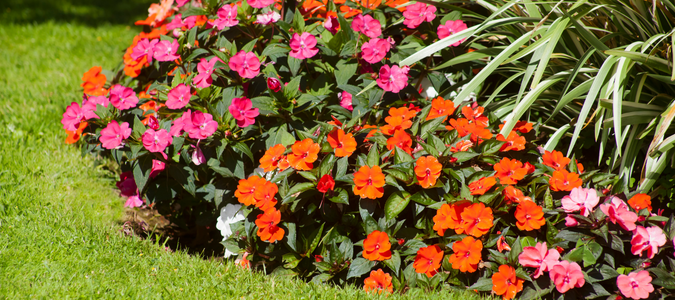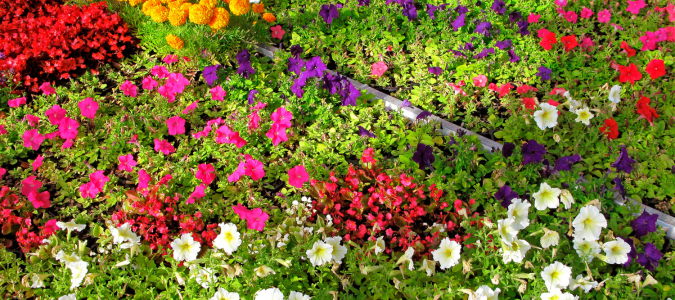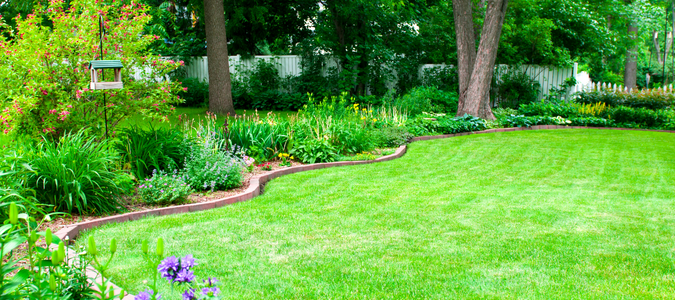Do you want to add a beautiful flower bed to your property? The most intimidating part of this project is deciding what it will look like. When it comes to designs, colors and layout, the options are endless. The good news is that there is plenty of room for fun experimentation.
This guide will provide a step-by-step guide on how to make a flower bed, annual flower bed ideas and flower bed edging ideas. For the best results, contact a landscaping specialist for help.
How To Make a Flower Bed
The first step to making a flower bed is to choose the right location on your property, and you have several options when it comes to aesthetics. A few possibilities are in your front yard, behind a pool and along the fence line in your backyard.
Flowers will not survive in waterlogged soil, so make sure you choose a spot with proper drainage, or you will need to improve the drainage yourself.
Next, consider the layout of your flower bed. Depending on your preference and the available space, you can choose from various shapes, such as circular, rectangular or curvy borders.
To help you choose the perfect layout, consider the look you want to achieve with your flower bed. Curvy borders often create a more natural and inviting look, while straight lines offer a formal and organized appearance. Keep in mind the style of your house when choosing flower bed design.
It’s helpful to look at pictures to decide what you want. You could also map it out by taking measurements and marking the area with a water hose or marking paint.
Finally, for the fun part, choose the types of flowers you want to plant. Experts recommend planting a mix of annuals, perennials and evergreen shrubs so that you have something that blooms all year long. Consider the amount of sun you receive and the maximum size of the plans when choosing. Them.
Research different types of flowers to learn about the flowering times and how tall they typically grow. For a beautiful garden with plenty of texture, choose a wide variety of flowers with different shapes, heights and colors for the most visual appeal.
Tools and Materials Needed to Make a Flower Bed
Once you’ve decided on the location, layout and flowers you want to plant in your new bed, it’s time to gather your tools and materials.
You will need a shovel and trowel, gardening gloves to protect your hands and a hose or watering can. The materials you need include compost or organic matter to enrich the soil, mulch to suppress weeds and fertilizer to nourish the flowers.
If you want to add edging to your flower bed, gather those materials as well. Popular edging options include stone, brick and steel edging.
Planting Your Flower Bed
When you are ready to plant your flowers, the first step is to prepare the bed. Remove all vegetation and weeds before loosening the soil with a shovel. Next, mix in compost or organic matter to improve the soil structure and boost its fertility. Rake the bed so that the soil has a level surface, and break up any clumps of soil with your rake or shovel.
Before you start digging holes for each flower, arrange them on the bed in the containers that you purchased them in. This will give you a chance to see what the configuration looks like and move flowers around before you plant them.
When you’re happy with your layout, dig holes for each flower. They need to be deep enough to accommodate the roots. After you put the flowers in their holes, backfill them around the plant, being careful not to pile soil above the base of the plant.
After planting, water the flowers generously so that they will establish roots. Mulch after planting to keep weeds away and lock in moisture.
To maintain your flower bed, water it regularly and fertilize and prune as needed. For the best results, hire a professional landscaping specialist for help. They can bring your vision to life by helping you choose the right location, layout and flowers for your bed. Additionally, they can handle the planting and maintenance for you.
Annual Flower Bed Ideas
Annual flowers can provide several benefits to your flower bed, which is why lawn service specialists recommend planting them along with perennials. Annuals get their name because they are flowers that complete their lifecycle in one year. As opposed to perennials that come back year after year, annuals die off in the winter.
Annuals add beauty to gardens because they come in a variety of shapes, heights and colors. Common annual flowers include petunias, zinnias, begonias, marigolds and pansies.
They are also easy to grow and attract pollinators to your garden. Annuals are great for filling in empty spots in your garden, and they give you an opportunity to experiment with variety since you can replant them each year.
For a more uniform look, plant your annuals in groups by flower type. If your flower bed design has empty spots, adding an annual plant is a great way to fill them in.
For more information on annuals and help with the planting process, contact a landscaping specialist.
Flower Bed Edging Ideas
Adding edging to your flower bed has several benefits, both visually and functionally. Edging makes your flower bed look more polished and complete. On the practical side, edging can keep weeds and other grasses out of your flower bed.
There are several types of edging, including mowing strips, mulch capture, curved landscape edging and stone or brick edging.
Landscape edging comes in a variety of designs, colors and materials to suit your garden. They provide a clean boundary between your garden and the rest of your yard. You can get metal, plastic or stone dividers. To install them, simply dig a trench around your flower bed so that you can insert the edging.
Next, you can create a mowing strip by laying down bricks, pavers or concrete between your flower bed and your lawn. Unlike dividers, which stand up, mowing strips lay flush to the ground. Mowing strips are effective at keeping grass from creeping into your flower bed, and they create clear lines for mowing.
Other Options for Edging
If you want a clean and simple look, rather than decorative edging, mulch capture is a great option for you. It still serves a valuable purpose by keeping your mulch in your garden, which means you won’t have to add new mulch as often.
Next, curved landscape edging adds beautiful fluid lines along the edges of your flower bed. It comes in flexible materials, such as plastic or light metal, so you can shape it as you like. Curved landscape edging adds an organic and elegant look to your garden, and it helps keep out grass.
Finally, stone or brick edging is a timeless choice. It adds natural beauty and sophistication to your flower bed while also serving a valuable purpose as a sturdy barrier to many types of weeds and grass. There are several types of stones and bricks to choose from, so you can pick one that perfectly matches your garden style.
To find the perfect edging option for your garden, contact a landscaping specialist.
Create Your Dream Flower Bed With Professional Assistance
A new flower bed will add vibrance and joy to your property. When you give them the right conditions and care, most flower beds are also easy to maintain.
Still not sure what types of flowers will thrive on your property, or where you should plant them for the best light and drainage? Contact a local landscaper for expert assistance.
They will help you determine where to plant your flower bed, what flowers to plant and the best layout. They can also assist you in the planting and maintenance process so that your flower bed can thrive.
ABC Can Help You Create the Yard of Your Dreams
As a homeowner, there are so many things you have to stay on top of, and the laundry list of tasks never seems to get any shorter. ABC Home & Commercial Services can make it so you have one less thing to worry about. We can take on all your lawn care needs without you having to lift a finger. Our pros can do it all, even recommending drought-tolerant plants, so your yard stays vibrant through dry periods.



